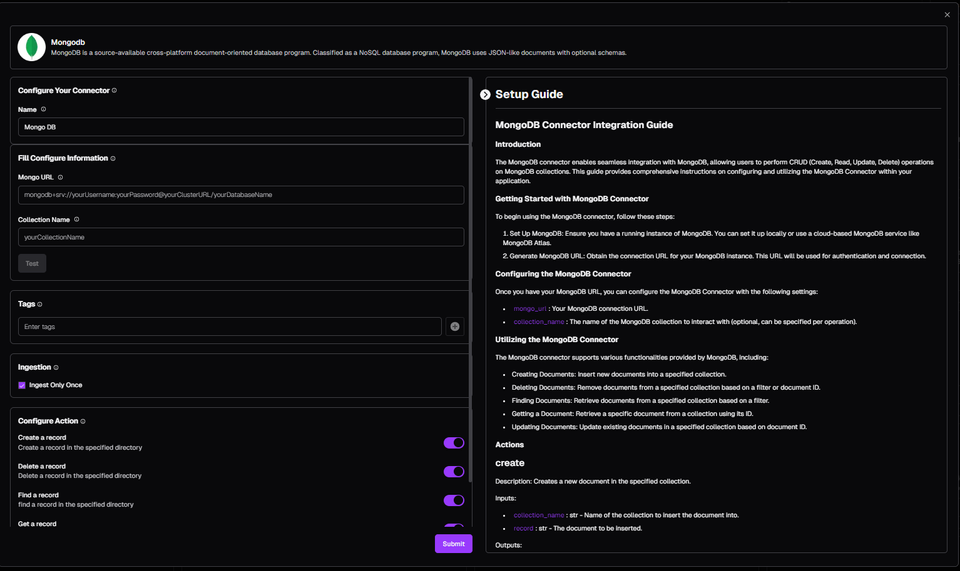MongoDB Connector Integration Guide

Introduction
The MongoDB connector enables seamless integration with MongoDB, allowing users to perform CRUD (Create, Read, Update, Delete) operations on MongoDB collections. This guide provides comprehensive instructions on configuring and utilizing the MongoDB Connector within your application.
Getting Started with MongoDB Connector
To begin using the MongoDB connector, follow these steps:
- Set Up MongoDB: Ensure you have a running instance of MongoDB. You can set it up locally or use a cloud-based MongoDB service like MongoDB Atlas.
- Generate MongoDB URL: Obtain the connection URL for your MongoDB instance. This URL will be used for authentication and connection.
Configuring the MongoDB Connector
Once you have your MongoDB URL, you can configure the MongoDB Connector with the following settings:
mongo_url: Your MongoDB connection URL.collection_name: The name of the MongoDB collection to interact with (optional, can be specified per operation).
Utilizing the MongoDB Connector
The MongoDB connector supports various functionalities provided by MongoDB, including:
- Creating Documents: Insert new documents into a specified collection.
- Deleting Documents: Remove documents from a specified collection based on a filter or document ID.
- Finding Documents: Retrieve documents from a specified collection based on a filter.
- Getting a Document: Retrieve a specific document from a collection using its ID.
- Updating Documents: Update existing documents in a specified collection based on document ID.
Actions
create
Description: Creates a new document in the specified collection.
Inputs:
collection_name: str - Name of the collection to insert the document into.record: str - The document to be inserted.
Outputs:
created_document: str - The created document.
delete
Description: Deletes documents from the specified collection based on a filter or document ID.
Inputs:
collection_name: str - Name of the collection to delete documents from.filter_key: Optional[str] - Key to filter documents by.filter_value: Optional[str] - Value to filter documents by.id: Optional[str] - ID of the document to delete.
Outputs:
status: str - Status of the delete operation.
find
Description: Finds documents in the specified collection based on a filter.
Inputs:
collection_name: str - Name of the collection to find documents in.filter_key: Optional[str] - Key to filter documents by.filter_value: Optional[str] - Value to filter documents by.
Outputs:
found_records: str - The found documents.
get
Description: Retrieves a specific document from the specified collection using its ID.
Inputs:
collection_name: str - Name of the collection to get the document from.id: str - ID of the document to retrieve.
Outputs:
record: str - The retrieved document.
update
Description: Updates an existing document in the specified collection based on document ID.
Inputs:
collection_name: str - Name of the collection to update the document in.id: str - ID of the document to update.record: str - The updated document.
Outputs:
updated_record: str - The updated document.
pull
Description: Fetches data about the provided configuration and ingests data into Qdrant storage.
Inputs: None
Outputs: None
Best Practices
- Indexing: Ensure proper indexing of your MongoDB collections to optimize query performance.
- Error Handling: Implement robust error handling mechanisms to gracefully handle errors encountered during database operations.
- Security: Securely manage and protect your MongoDB connection URL to prevent unauthorized access to your database.
Conclusion
In conclusion, the MongoDB Connector offers a powerful solution for performing CRUD operations on MongoDB collections through seamless integration with the MongoDB platform. By leveraging the capabilities of MongoDB, developers can build sophisticated data management workflows to streamline database operations and improve productivity. With proper configuration and utilization of the MongoDB Connector, users can harness the full potential of MongoDB to manage and manipulate data effectively.
